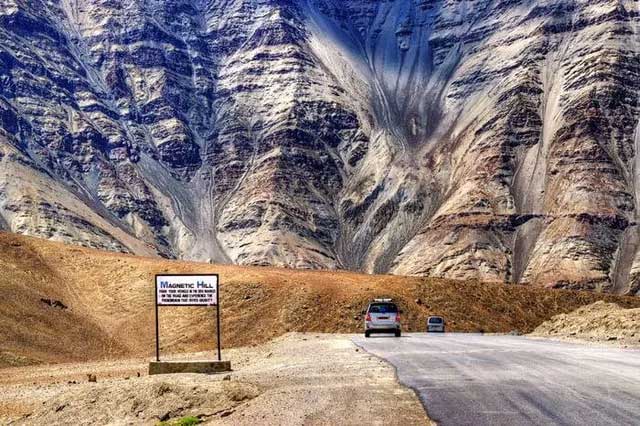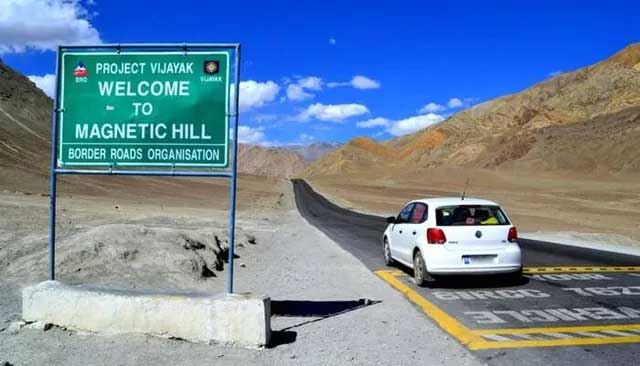Located about 30 km from the city of Leh along the Leh-Kargil highway in the Indian state of Jammu and Kashmir, there lies a peculiar hill that defies the laws of physics. This site has long captivated visitors due to its strange phenomenon, commonly known as the “Magnetic Hill.”
Finding the way to the hill is not difficult. The location sits at an elevation of 4,200 meters above sea level and greets visitors with a curious sign that reads: “Magnetic Hill – The Phenomenon That Defies Gravity.”
The hill’s peculiarity is that when drivers stop their vehicles at a marked point at the foot of the slope and turn off the engine, the car mysteriously rolls uphill at a speed of about 15 to 20 km/h.

This site has long captivated visitors due to its strange phenomenon.
Not only is it famous for its oddity, but the hill also serves as a popular tourist attraction in the valley, making it a perfect rest stop for weary travelers on the highway.
In the past, local residents believed that there was a road leading to heaven. However, only those deemed worthy could ascend this path. Conversely, the unworthy would never find it, no matter how hard they tried.
Due to the reputation of the Magnetic Hill, Indian Air Force planes have been rerouted to avoid magnetic interference. It is hypothesized that a force emanating from the hill compels pilots to gain altitude when flying over this area to avoid magnetic disruptions.
However, researchers explain that the high altitude of 4,200 meters above sea level leads to air turbulence and unusual weather phenomena. This is the true reason pilots prefer to steer clear of this area.
The strange phenomenon on the “Magnetic Hill” has attracted tourists from around the world who come to experience and verify it. Consequently, numerous scientific hypotheses have been proposed to explain the anti-gravity phenomenon, aiming to debunk many superstitious tales previously circulating.

One hypothesis suggests that the vehicles rolling uphill with engines off is simply a result of a visual illusion. This illusion makes the sloping road leading to Magnetic Hill appear like a mountain. Thus, many people mistakenly believe their vehicles are going uphill when, in reality, they are going downhill. Additionally, scientists have dismissed any claims of “supernatural forces” from the hill in Leh.
Another factor influencing this phenomenon is the wind speed in the area, which can reach up to 15 km/h. Experts also note that air turbulence and unusual weather phenomena frequently occur at Magnetic Hill due to its high elevation of over 4,200 meters. As a result, pilots tend to avoid this region.
Regardless of the cause, Magnetic Hill remains a major tourist attraction in India. Many visitors have documented their experiences with enthusiasm and shared that the ideal time to visit is from July to September each year. During this period, the roads are quite clear, and the weather is relatively pleasant, allowing visitors to fully enjoy the enchanting beauty of Ladakh.
Other locations around the world with similar environmental conditions are also referred to as magnetic mountains, gravity hills, or haunted hills. These places often feature a road that stretches across hilly terrain, where the horizon is unclear. Tourists can find magnetic hills in the UK, USA, Australia, Brazil, Saudi Arabia, South Korea, and more.
- The “Anti-Gravity” Slope: One of the Most Fascinating Places in the World
- Does Body Shape Determine Lifespan? Experts Reveal the Fate of People with Thick Necks and Big Bellies!
- The Mountain is the “Roof” of Southeastern Vietnam, Featuring Many Mystical Phenomena: A Photo Just Ranked First in the World!




















































